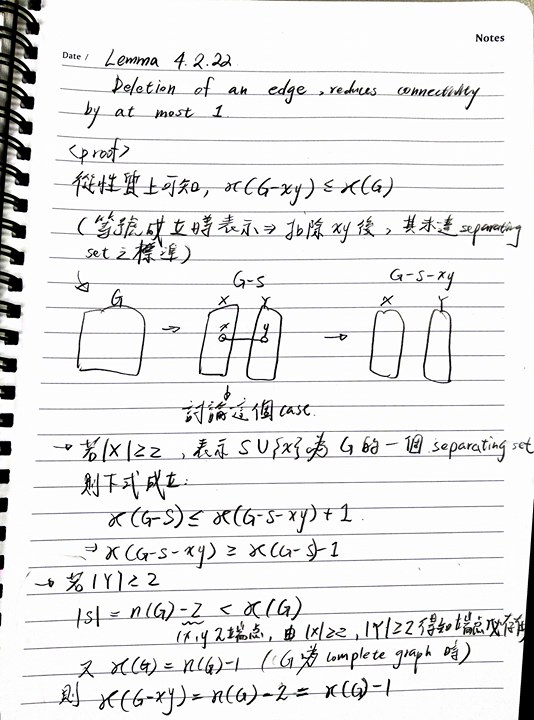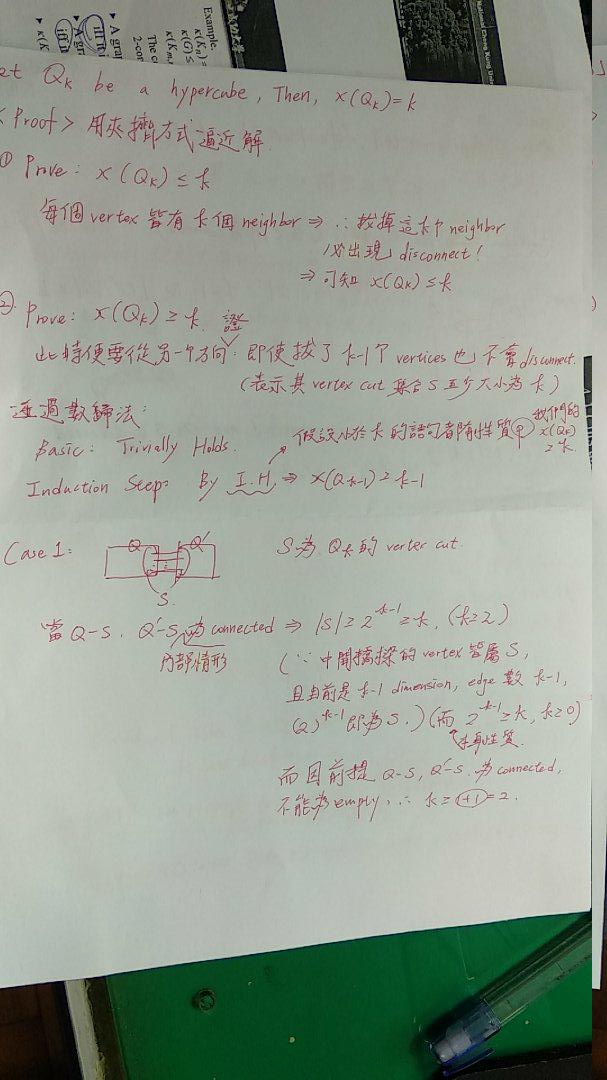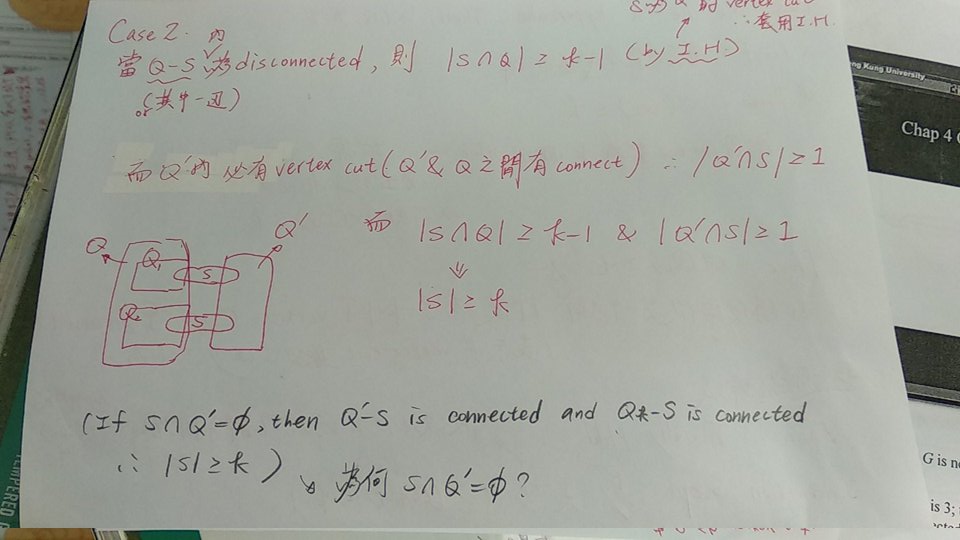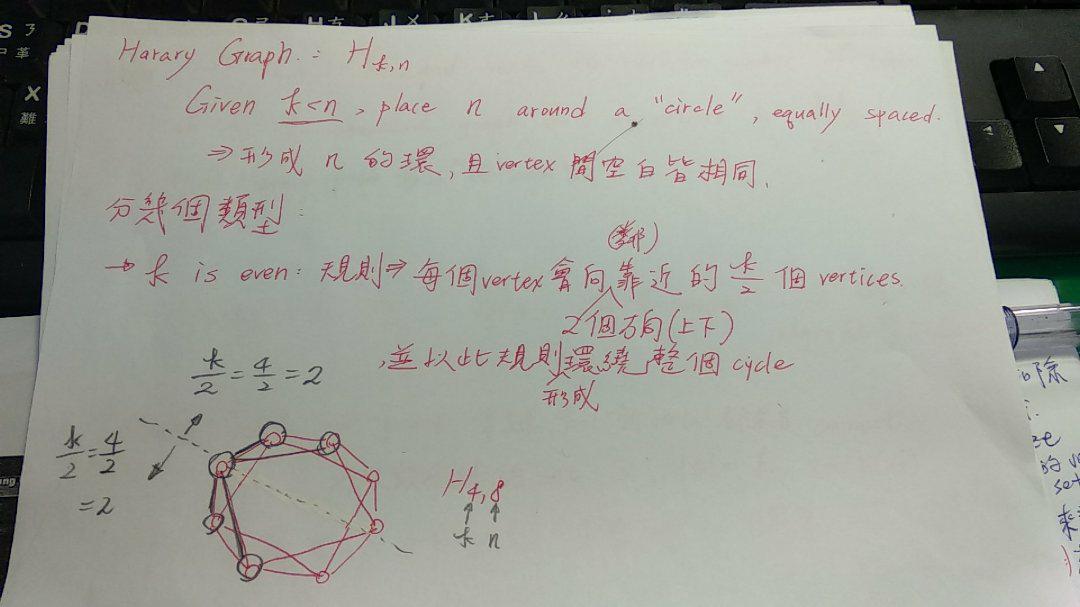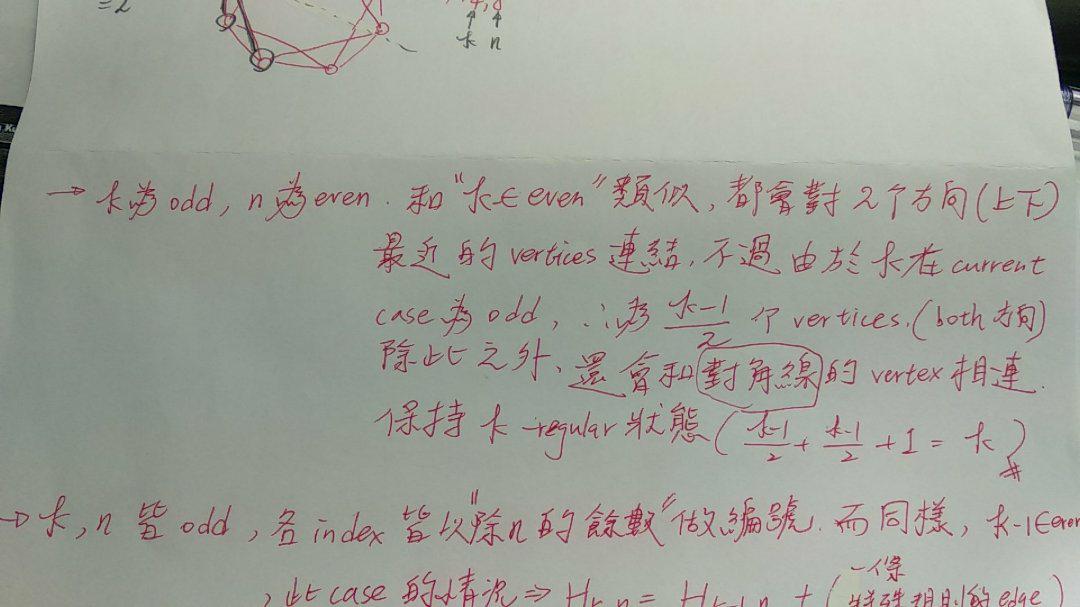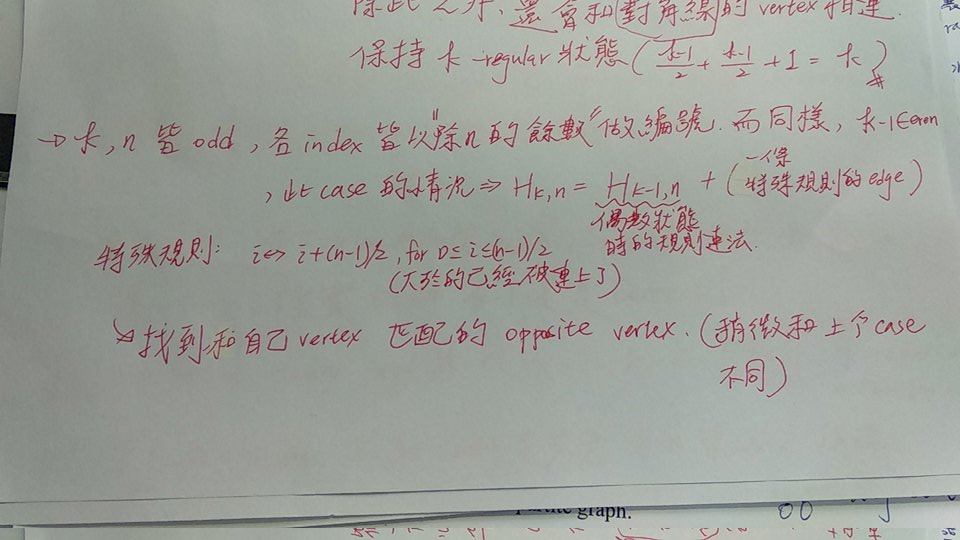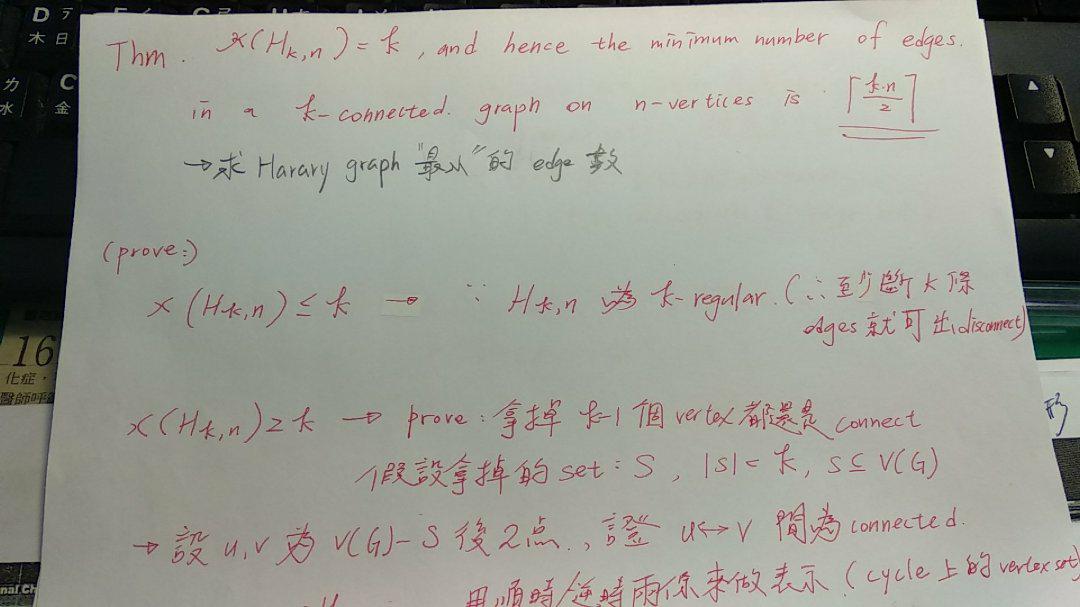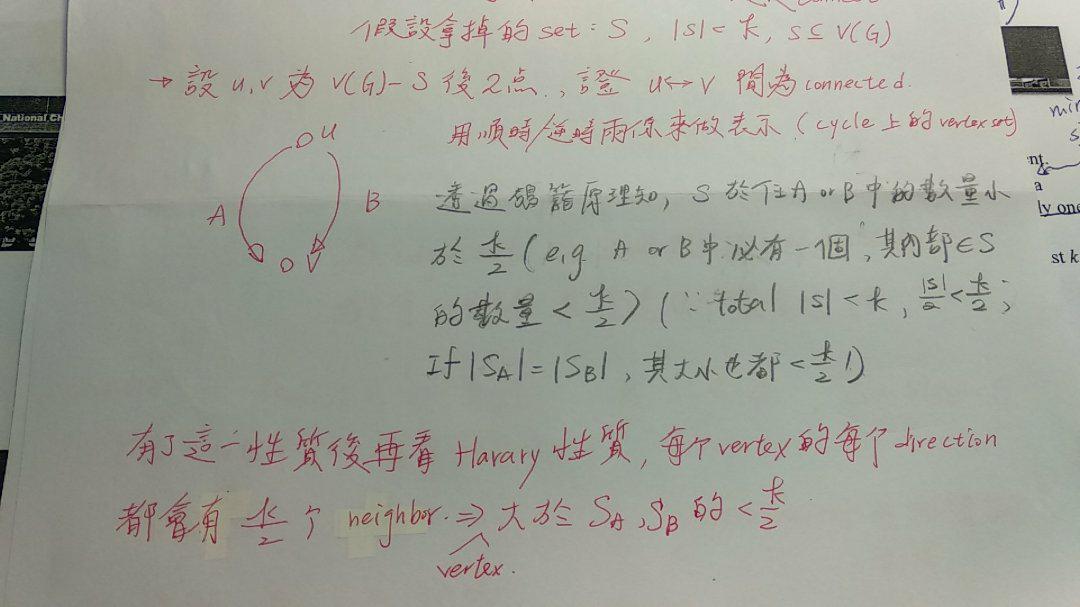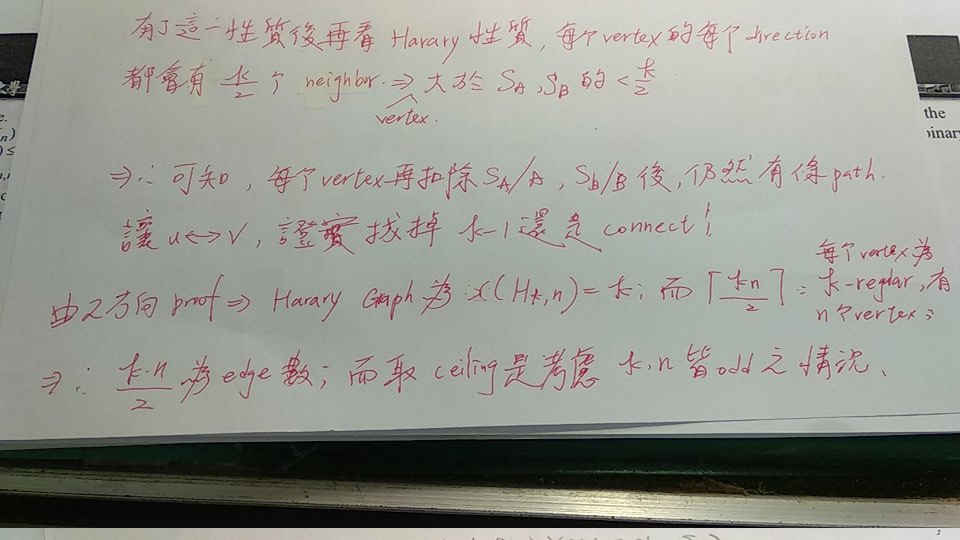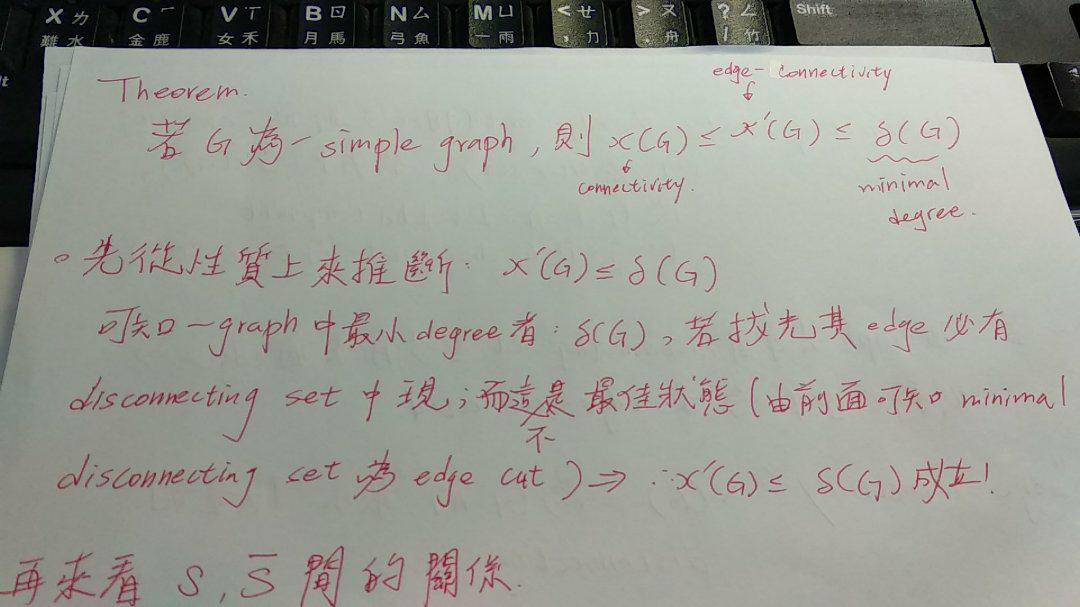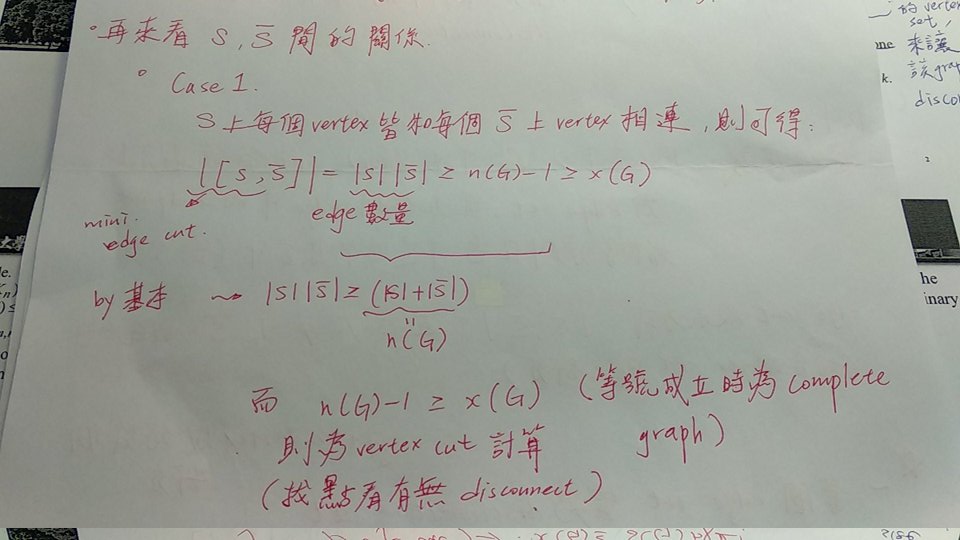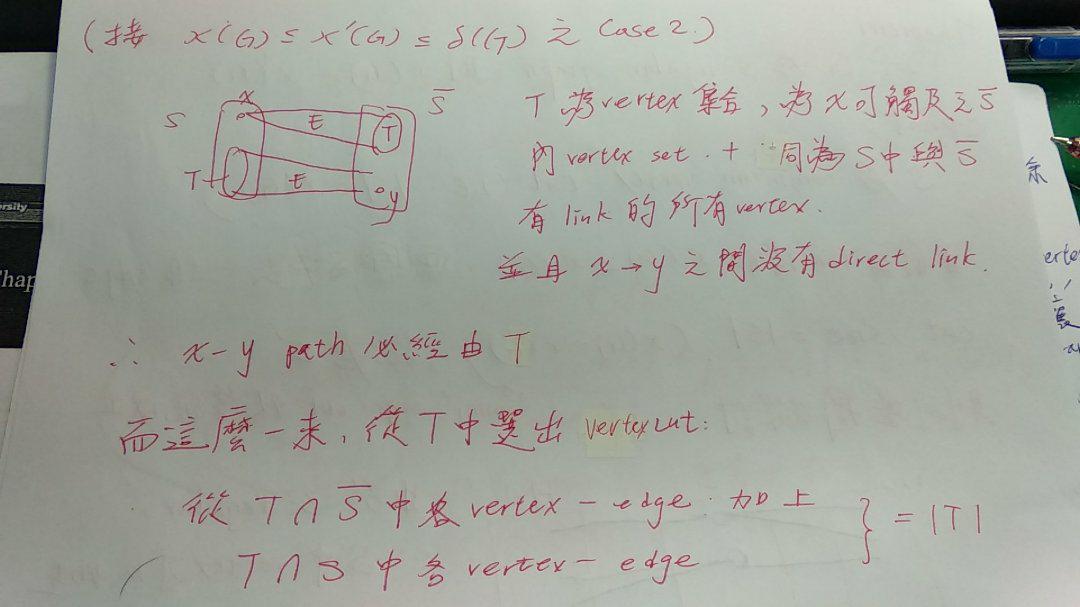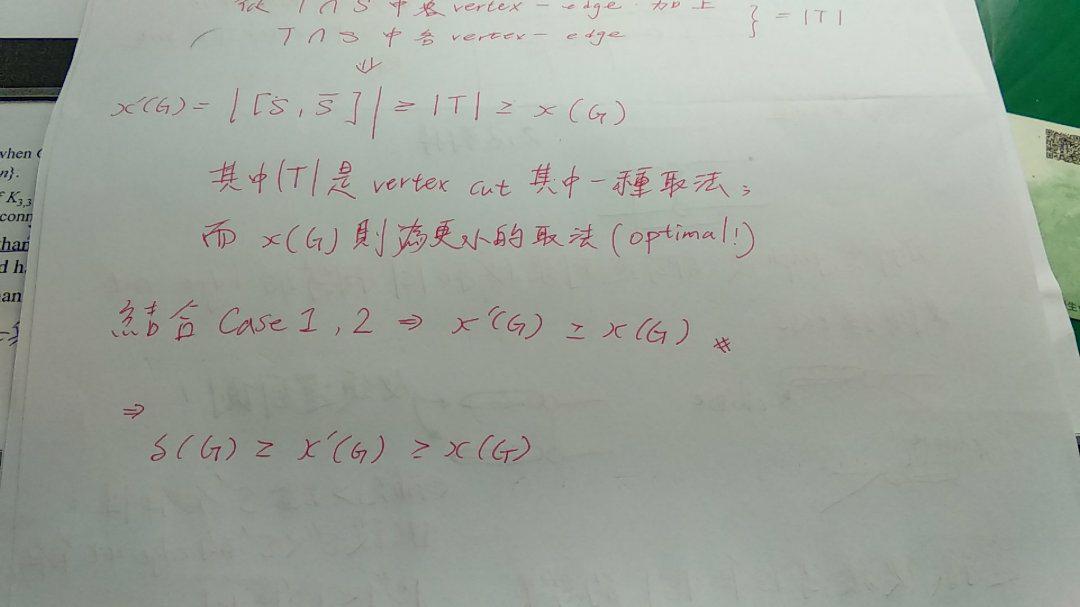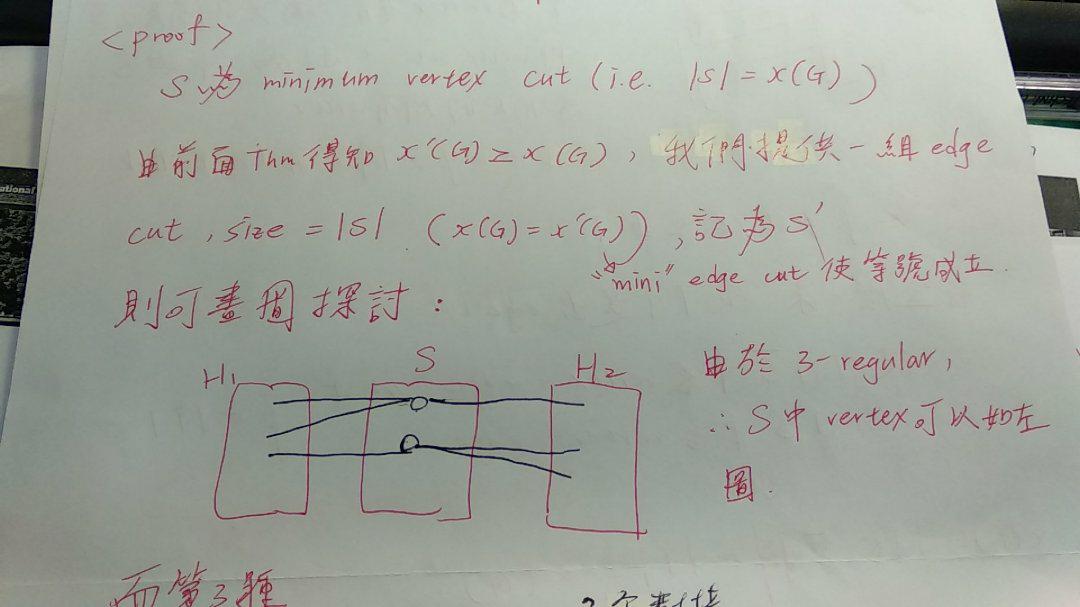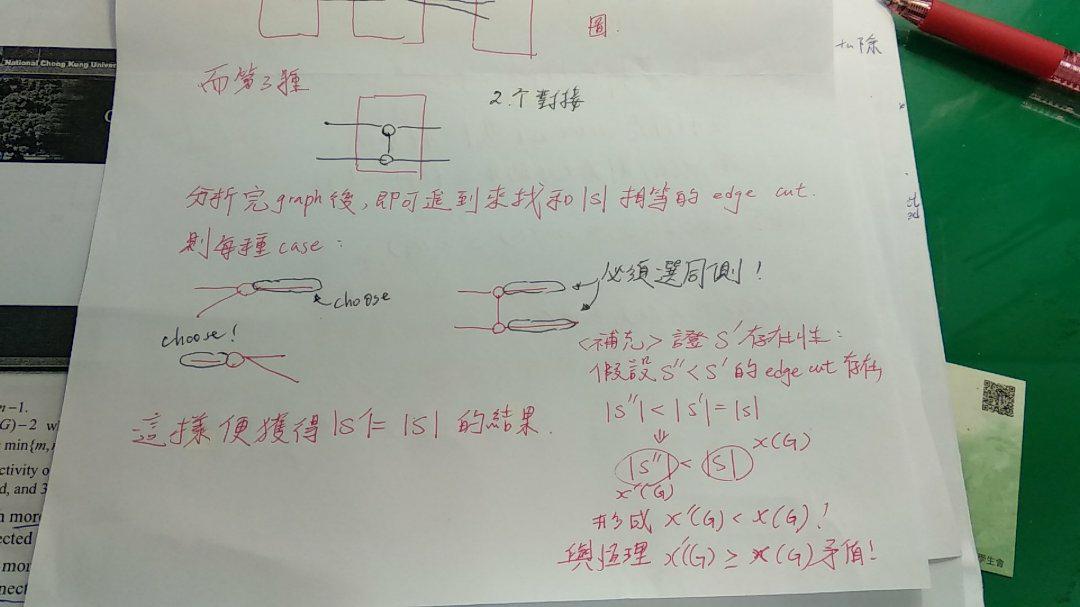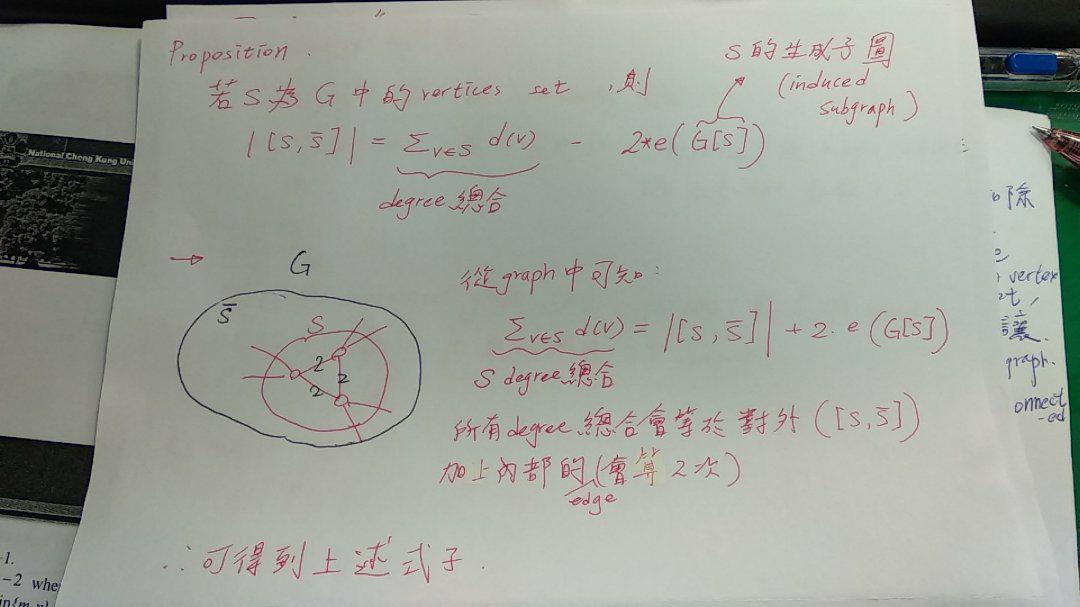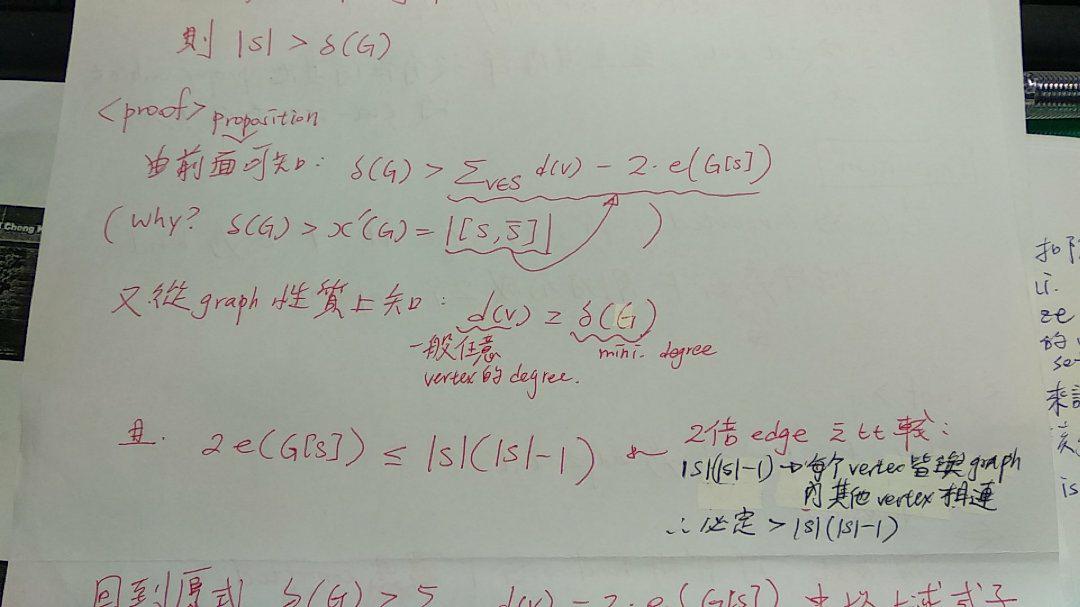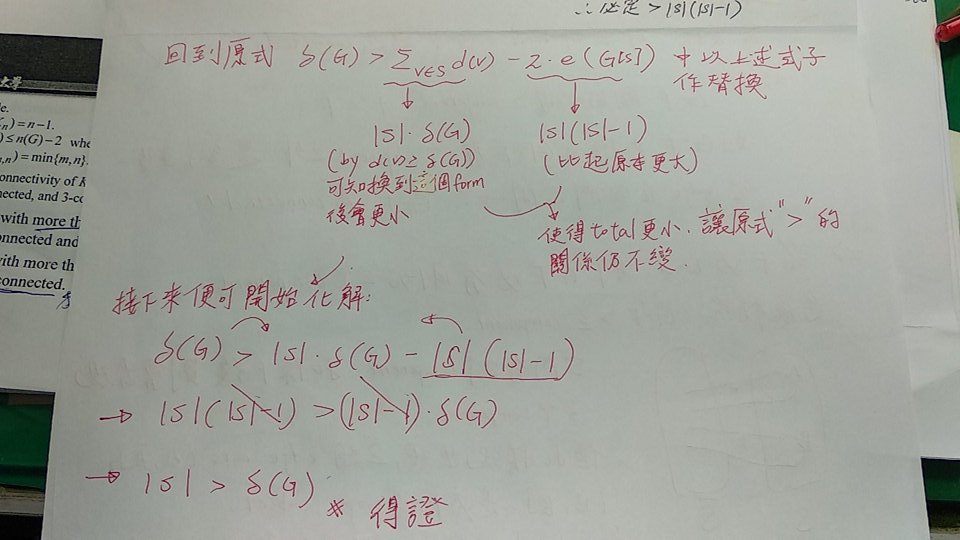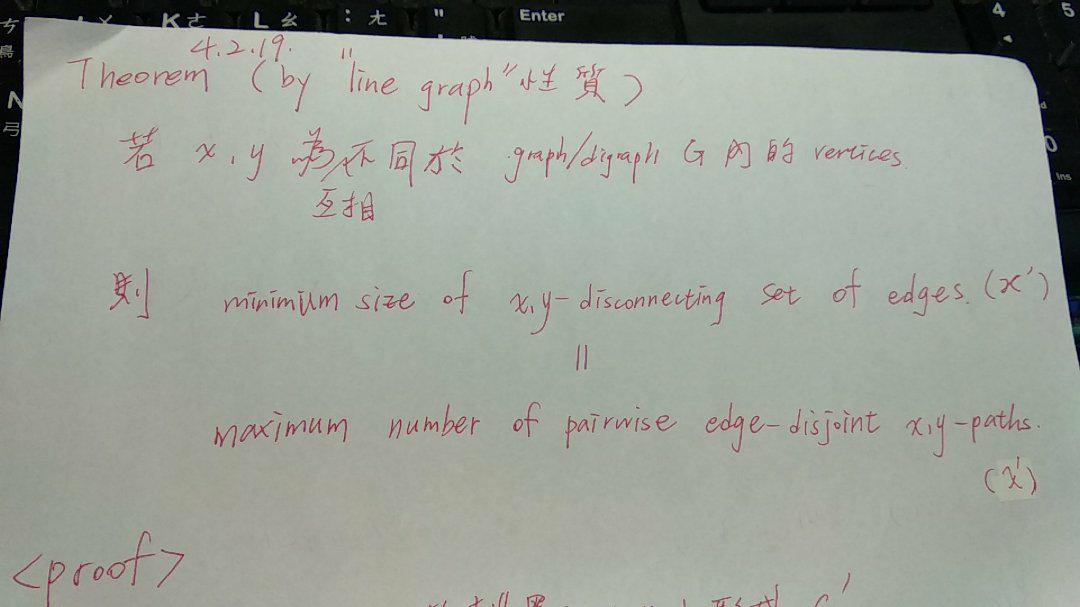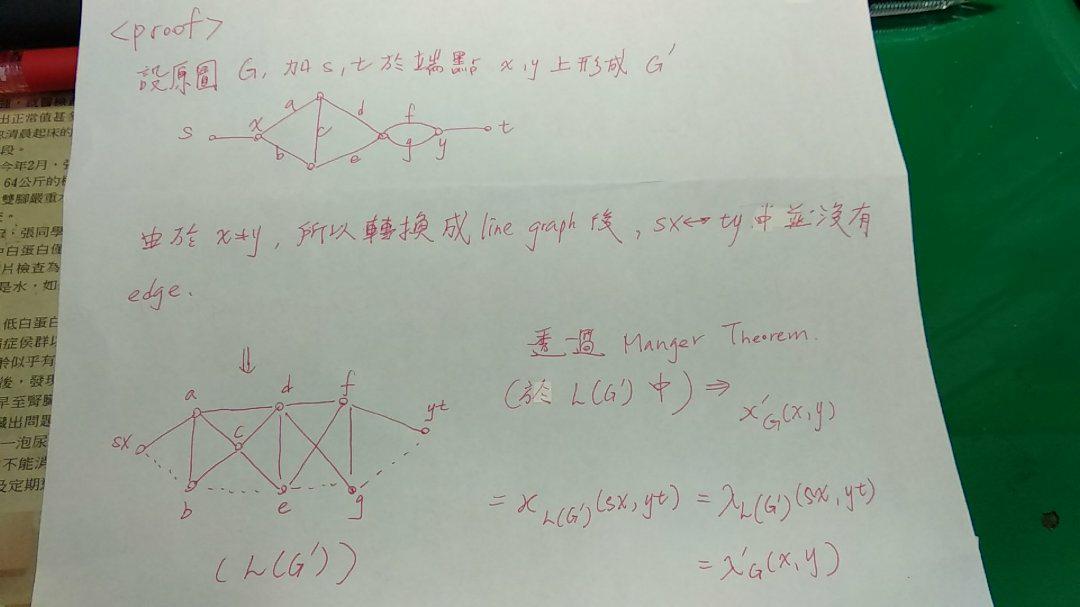Basic
kappa ϰ(G) - Separating set
唸做 kappa, 是為 connectivity,為 G 的最小 vertex 集合: S 的 size,其性質為 G-S 時會出現 disconnect 的現象,或是 G-S 只剩下 1 個 vertex(若 G 為 complete graph 時)
- 也就是 S 的 size 剛好是在構成 disconnect 要素的 threshold 上!
此時稱 graph G 為 k-connected,則表示其至少有值 = k 的 connectivity 存在!
- 而 S 則稱為 G 的
separating set,或是 vertex cut,S ⊆ V(G),且 G-S 會有多個 component 產生(e.g. disconnect)
ϰ(G) 性質
- ϰ(Kn) = n-1 (Complete Graph)
- ϰ(G) <= n(G)-2 (當 G 不為 Complete Graph)
- ϰ(Km,n) = min{m,n} (當 G 為 complete bipartite graph 時,取較小的 partite size 為
ϰ )
- ϰ(K3,3) = 3 : 表示其 graph 可為 1-connected, 2-connected, 3-connected
- 當一個 graph 為 connected 且有 cut vertex,則其 > 2 個 vertices 時,
connectivity > 1
- 若 graph > 1 vertex 時,其 connectivity 卻為 0 時,表示其 graph
本身便是 disconnected 狀態!
- ϰ(K1) = 0 (本身為一個 vertex 的情形,=0)
N 維度的 HyperCube
- 記做
Qn
- vertex 數量為
N=2^n
- 每個 vertex 上都以
n 個 bits 的二元字串來做表示 (也就解釋為何數量為 2^n)
- 每對鄰近的 vertices,兩兩之間只會有
1 bit 不同
Qn 為 bipartite graph
試證:
2 組 maximum matching 組合,其 edge 形成必為 even cycle
而 even cycle 則可以為 partite !
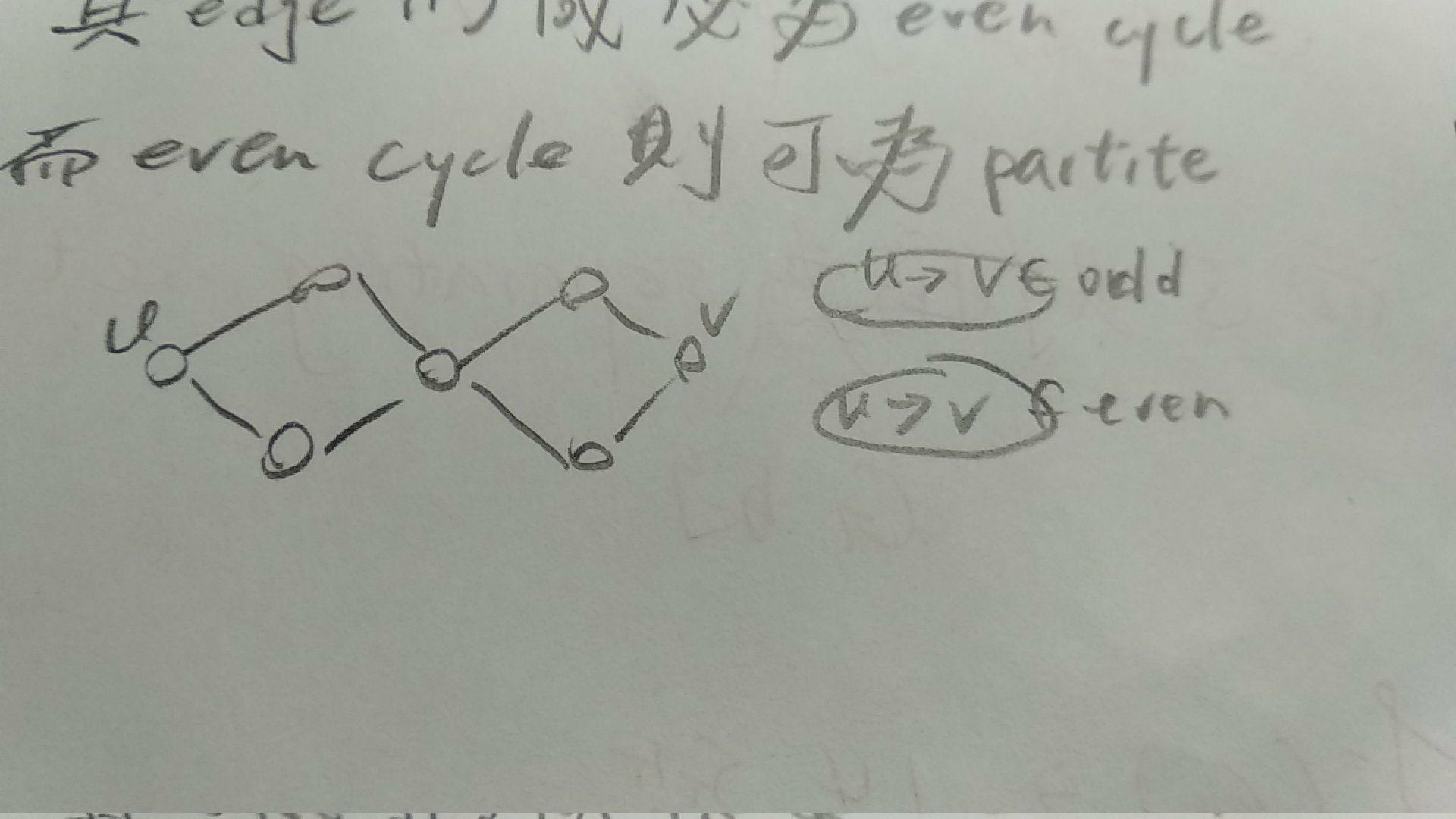
HyperCube 增長維度方式
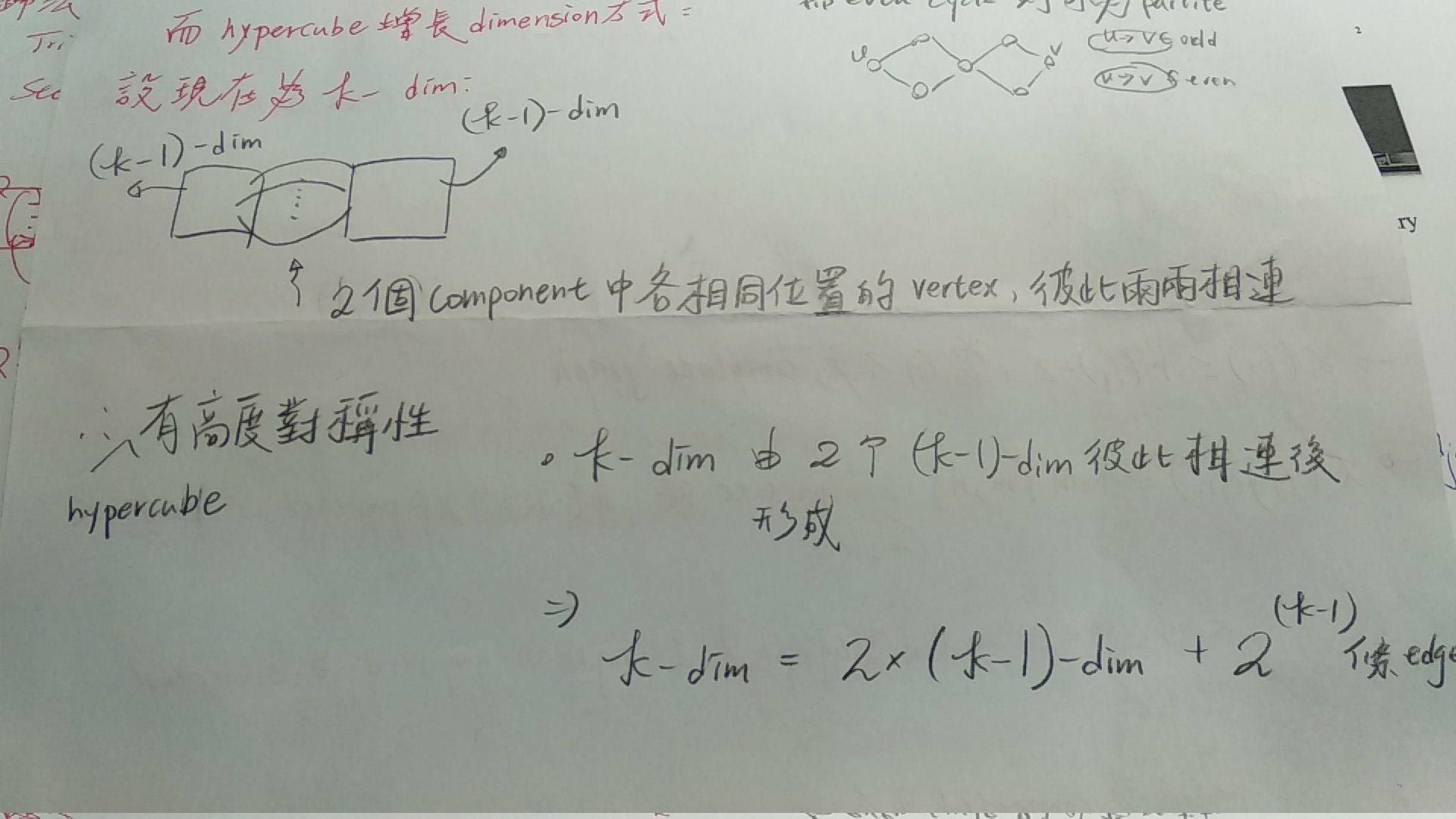
ϰ'(G) - Disconnecting set
Def - [S,T]
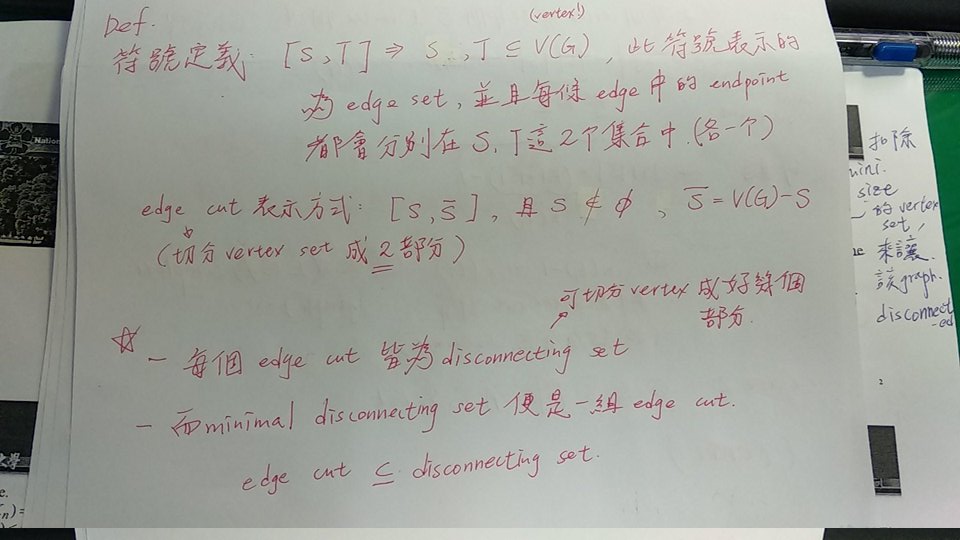
Def - line graph
- 標記為
L(G),表示為 graph G 的 line graph
- 用以做 graph 的轉換( 原本的 edge 會對應到 line graph 中的 vertex )
- 所以在後面 (Theorem 4-2-19) 的時候,就會用到 Line Graph 的這項性質!
- 並且在轉換時,會需要額外在端點加上偽 vertex,(讓原本端點 x,y 能夠搭配新加入的 vertex 形成 edge,並且轉換為 line graph 當中的 vertex )
Def - ear
Def - bond 的定義
bond 為一最小的 non-empty edge cut
(e.g. => 為 cut-set, 並且其內部 沒有任何其他的 proper subset 的 cut-set 存在)
Proposition
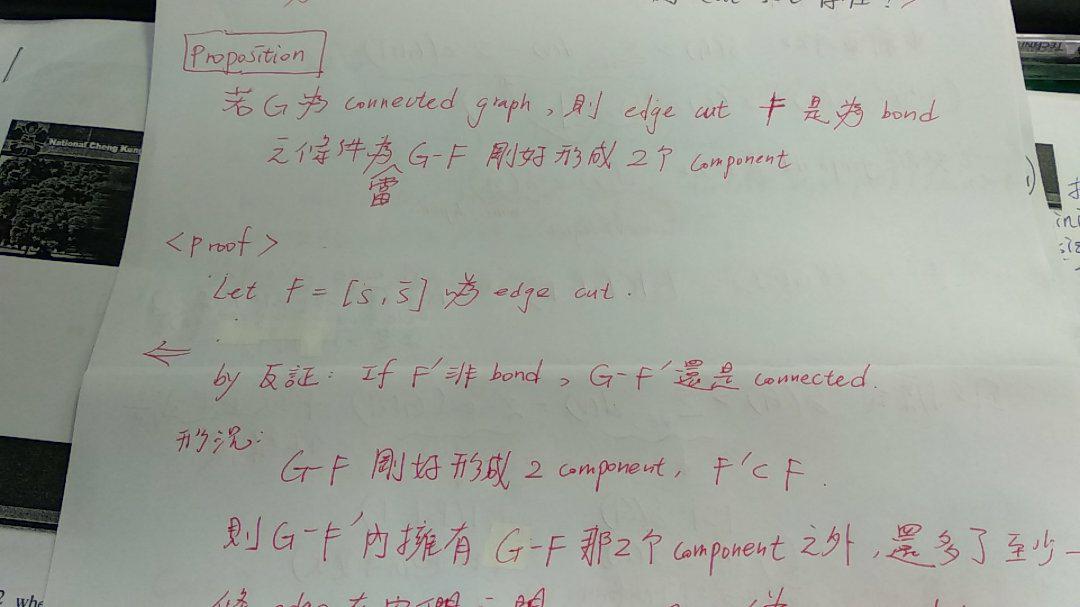
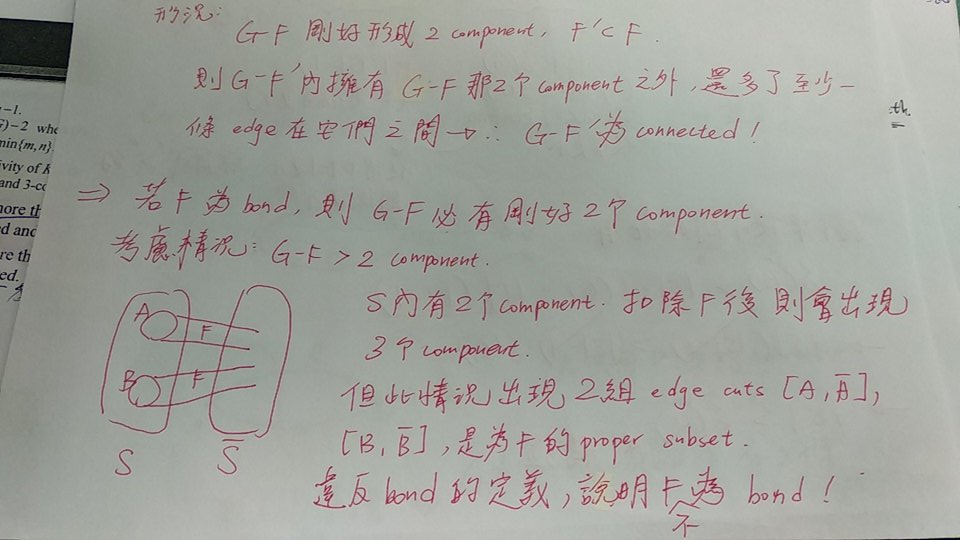
k-connected
Def - block
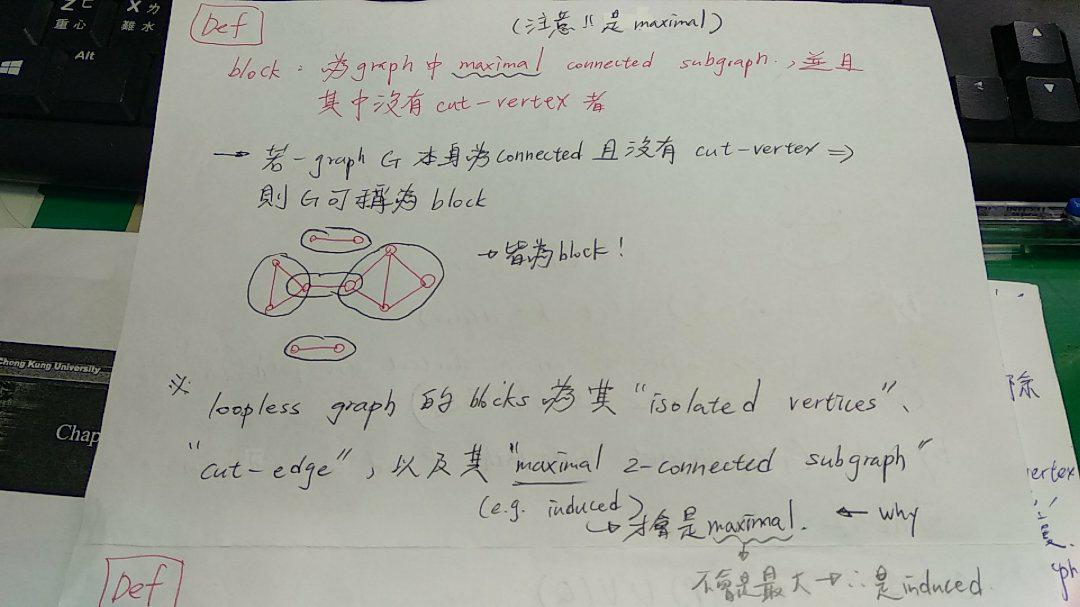
Def - internally-disjoint
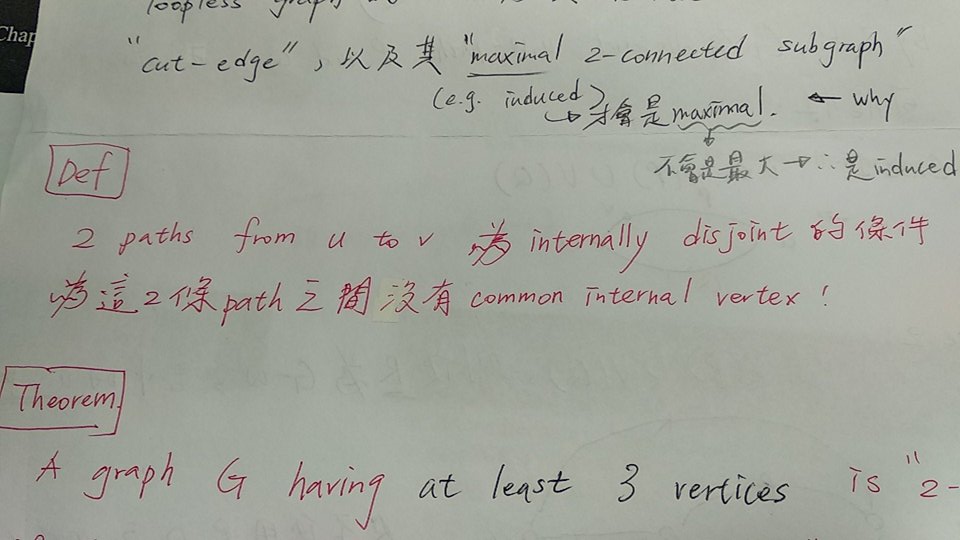
Theorem - 4.2.2
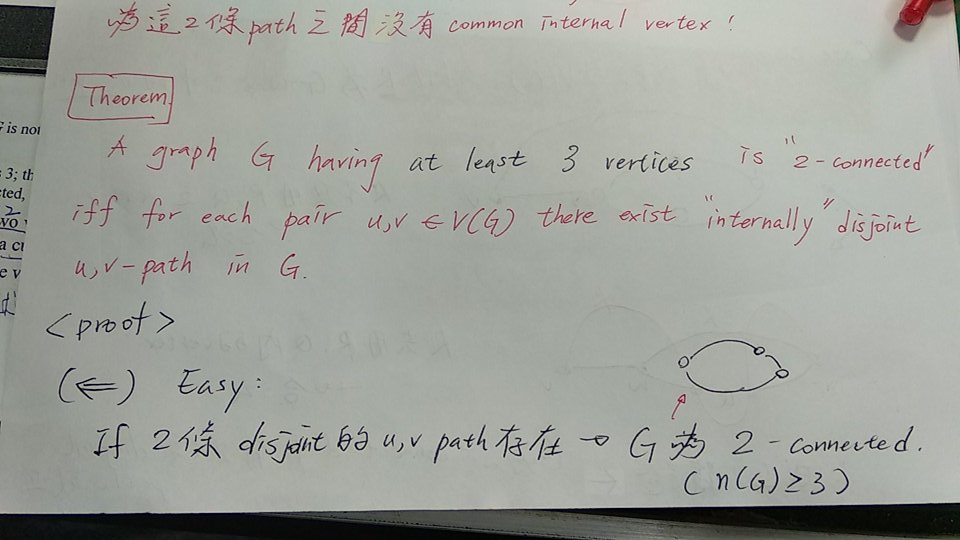
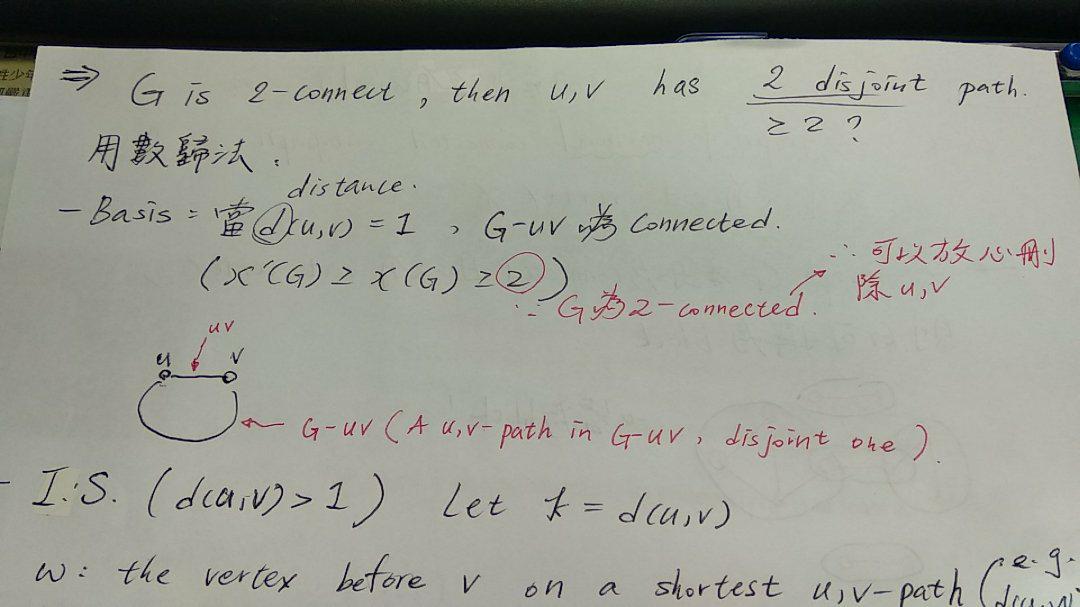
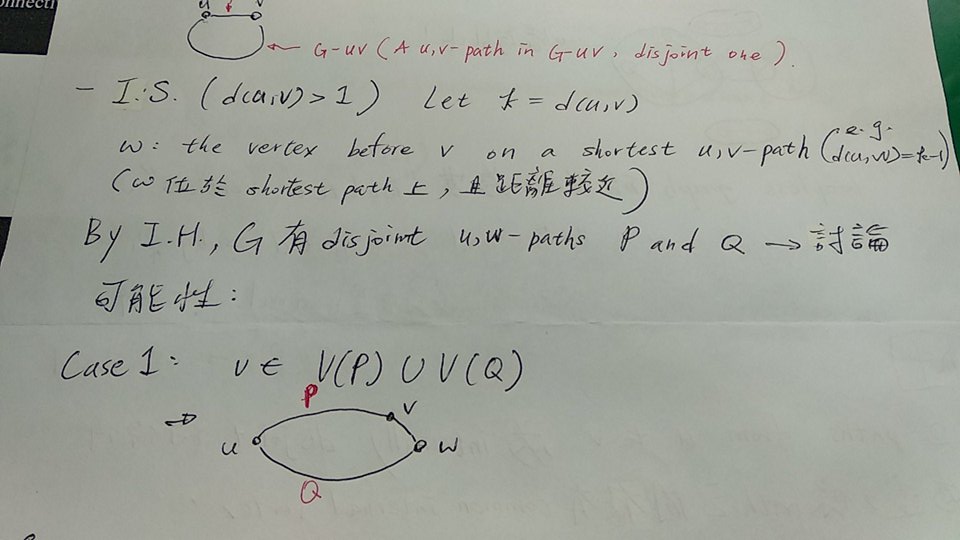
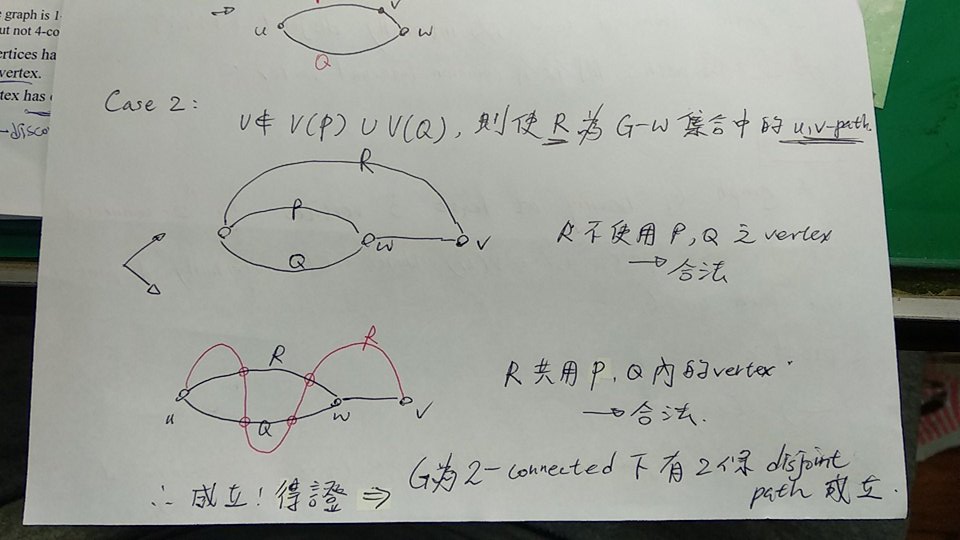
Lemma
當 G 為 k-connected graph,且 G' 是從 G 加上一個新的 vertex: y(並讓 y 擁有 k 個於 G 中的 vertex 做鄰居),則 G' 仍為 k-connected
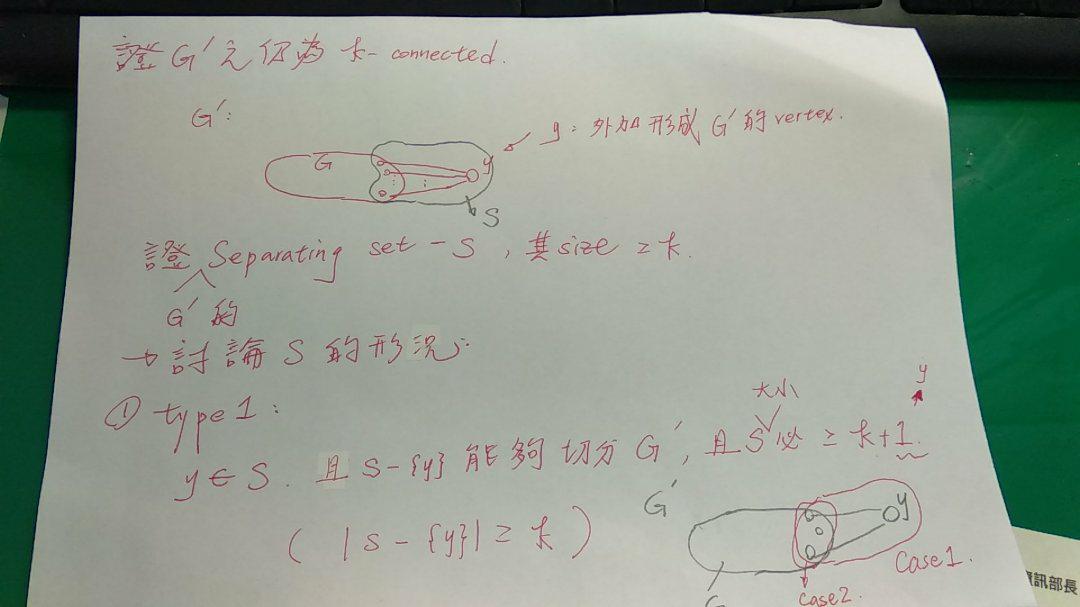
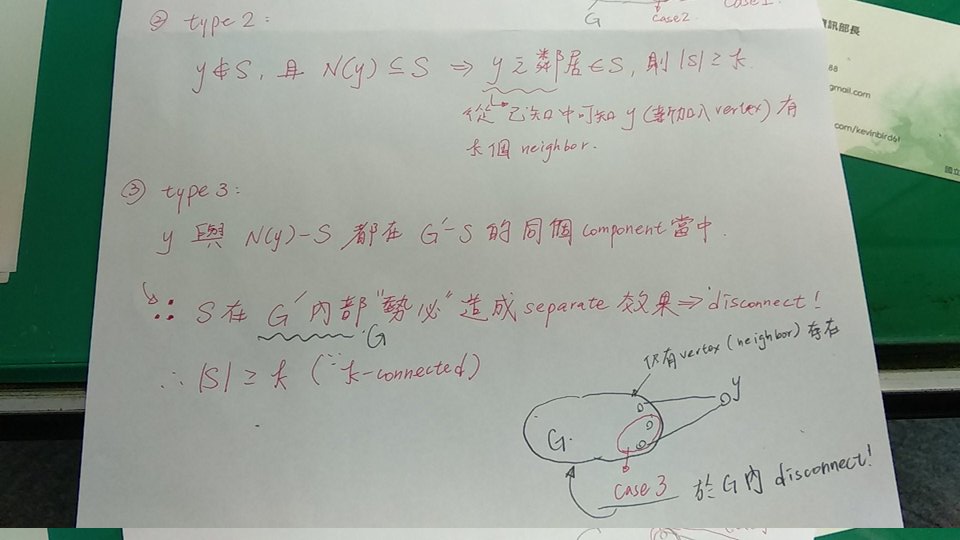
Theorem - equivalent 情況
對於一個擁有至少3個 vertices 以上的 graph G 來說,以下情況為等價:
A) G 為 connected 且沒有 cut-vertex
B) 對於屬於 G 的 vertex x,y,, 內部存在不相交的 x,y-paths
C) 對於屬於 G 的 vertex x,y,, 存在一個 cycle 穿過 x,y
D) δ(G) >= 1,且所有 pair of edges 會剛好在同一個 cycle 上 (e.g. 一定存在一 cycle 經過這 2 條配對邊)
Prove - A) <=> B)
由 Theorem 4.2.2 (上面)來做證明! 說明 A 與 B 互為等價
Prove - B) <=> C)
透過兩條 disjoint 的 x,y-paths 來組合這個通過的 cycle
Prove - D) => C)
- 從
δ(G) >= 1 可以知道, x 和 y 不是孤立點
- 再透過 D 內性質: pair of edges 落在同一個 cycle 上來說明,存在一 cycle 穿過 x,y
Prove - A) ^ C) => D)
- G 若為 connected,則表示 δ(G) >= 1 (D 的性質)
- 再來考慮兩條 edges: uv, xy
- 透過 subdivision 的方式從中生出一個中間點 w,z ;透過新生成的這兩條 edge:
uwv, xzy 來構成 cycle ( by 性質 C)
- 接著再刪除 subdivision 產生的新 vertex,來還原成原本的 edges;而這時可以知道,仍為兩條 disjoint edge; 那麼就可以證實, 原先這兩條 uv, xy 在這個 cycle 上(只是透過原先 uv, xy 來取代生成 cycle 的
uwv, xzy)
- 這樣就可以完成由 A 和 C 的聯集等價於 D 的結論
Theorem 4.2.17 - Menger Theorem
性質
-
兩點之間的 vertex cut 的最小值: ϰ(x,y),會等於其內部 pairwise disjoint x,y path(內部成對、不相交,不使用共同 vertex的 paths ) 的數量最大值: λ(x,y)
-
主要概念: 若存在兩點 x,y 並且他們之間不存在互相連通的 edge 時,這個時候我們便可以套用 Menger 定理!
- 透過兩點之間的 pairwise disjoint path、以及 vertex cut 間的關係來說明幾項特性!
- 像是
subdivision、line graph 等動作,都是為了要達到 Menger Theorem 所需要的狀態: 兩個不相鄰的 vertices,所加入的額外操作!
=> ϰ(x,y) = λ(x,y) by Menger 定理
=> ϰ'(x,y) = λ'(x,y) by Menger 定理(Edge 版本), Theorem 4.2.19 (這個就透過 line graph 來從 edge 轉換成 vertex 後套用 Menger 定理來證明! )
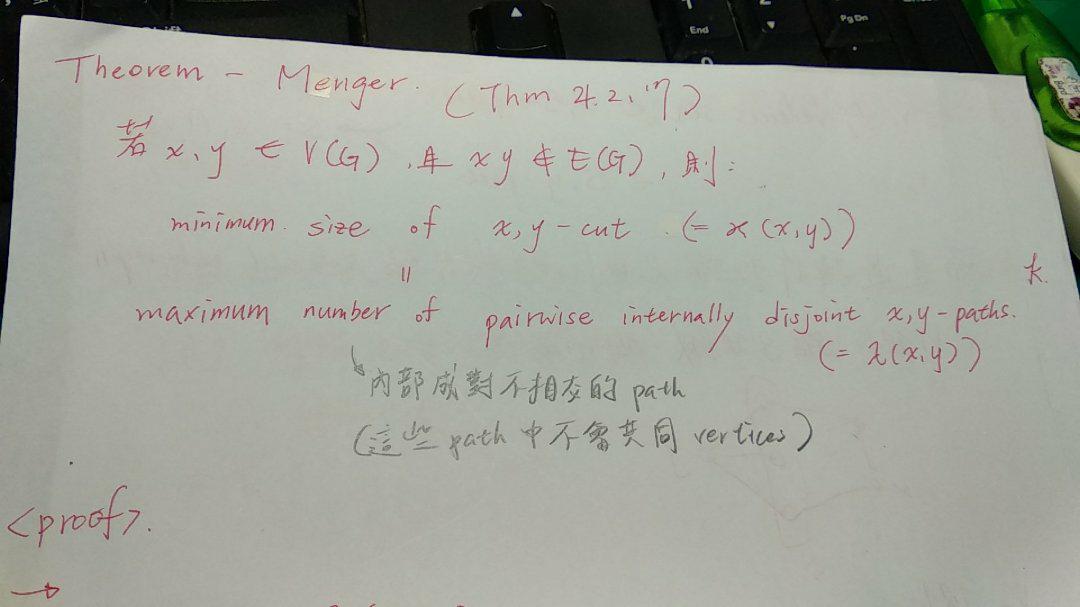
Proof
- 證明主要透過
節點數量 n(G)的狀況來做分析,並透過數學歸納法做證明
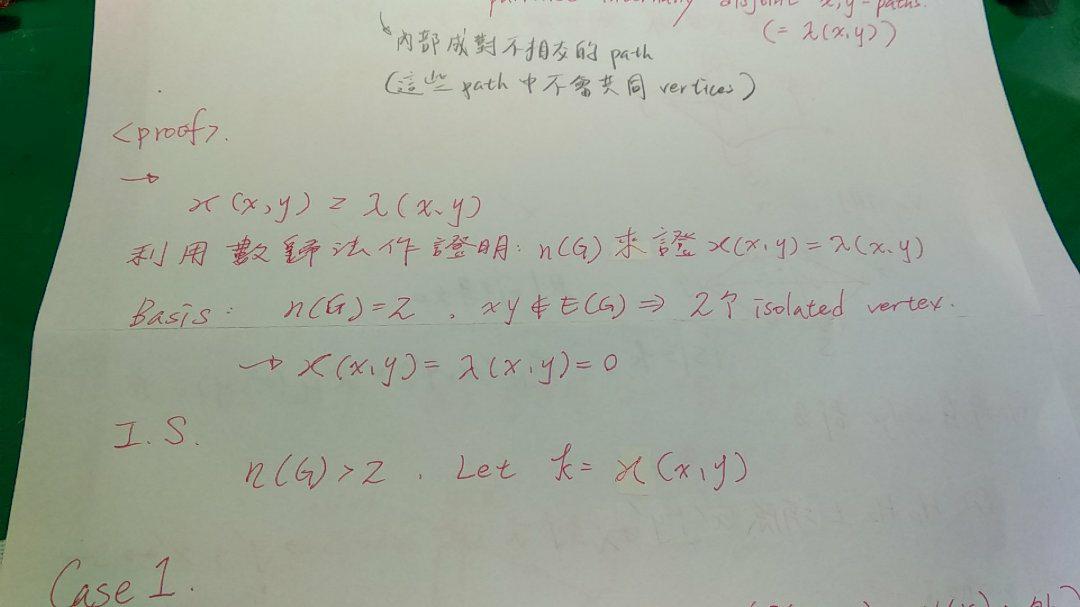
Case 1
Case 1 狀況為: 假設 x,y-cut: S 集合不為 x,y 的鄰居時的情況做分析
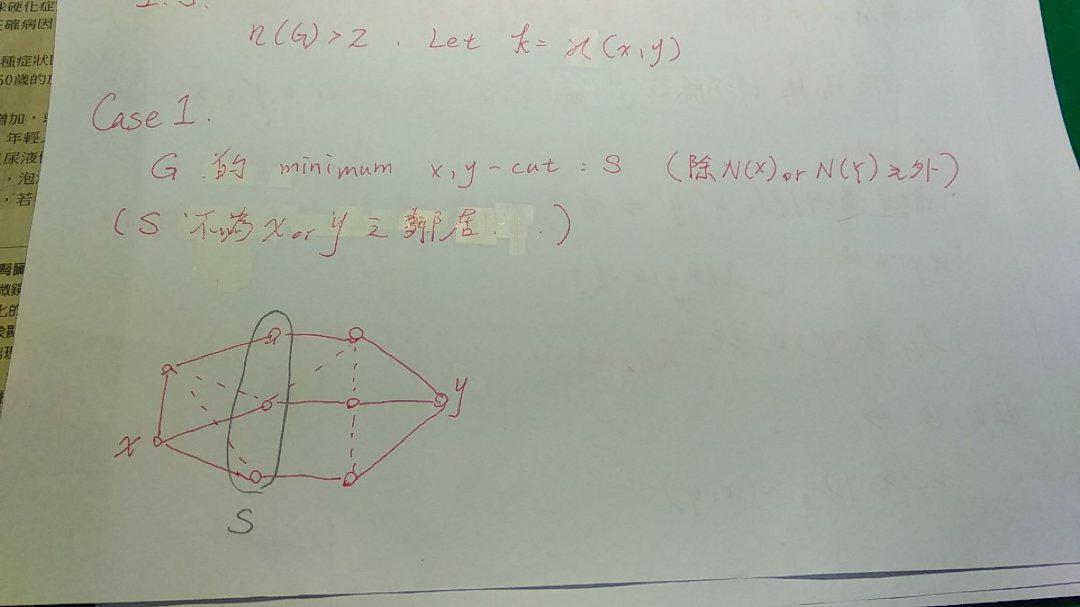
Case 1-1
藉由使得 x 側、 y 側收斂來說明,|S| = k, ϰ(x',y) = ϰ(x,y') = k (Case 1 中 connectivity 的部份)
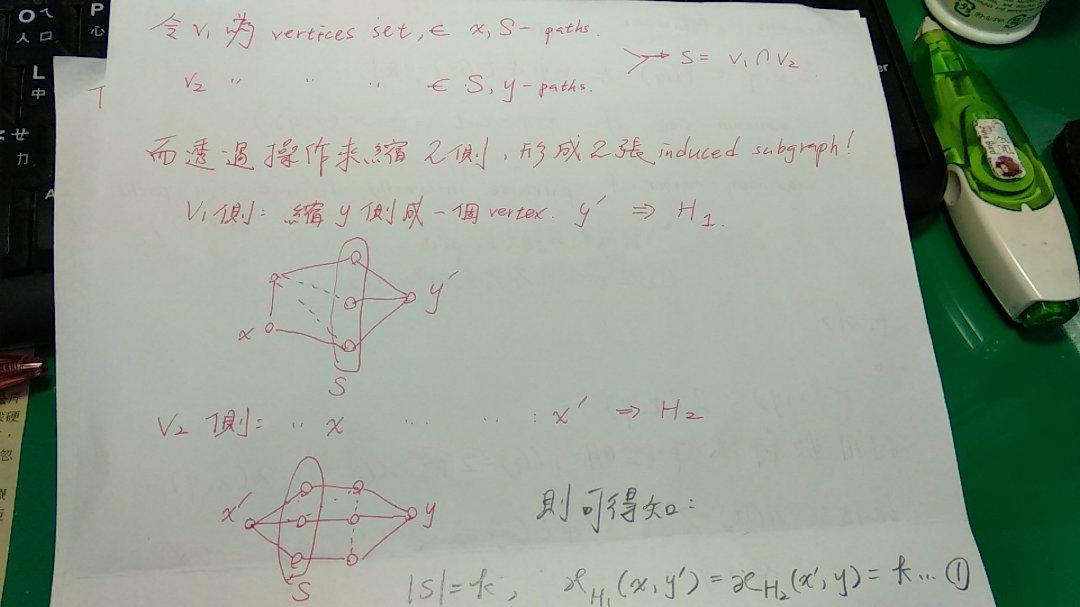
Case 1-2
從收斂的兩張圖可以看出,λ(x',y) = λ(x,y'),進而可以刪除 x',y' 來還原成原圖,可得 λ(x',y) = λ(x,y'), λ(x',y) = λ(x,y') = λ(x,y) = k( Case 1 中 pairwise disjoint x,y path 的部份)
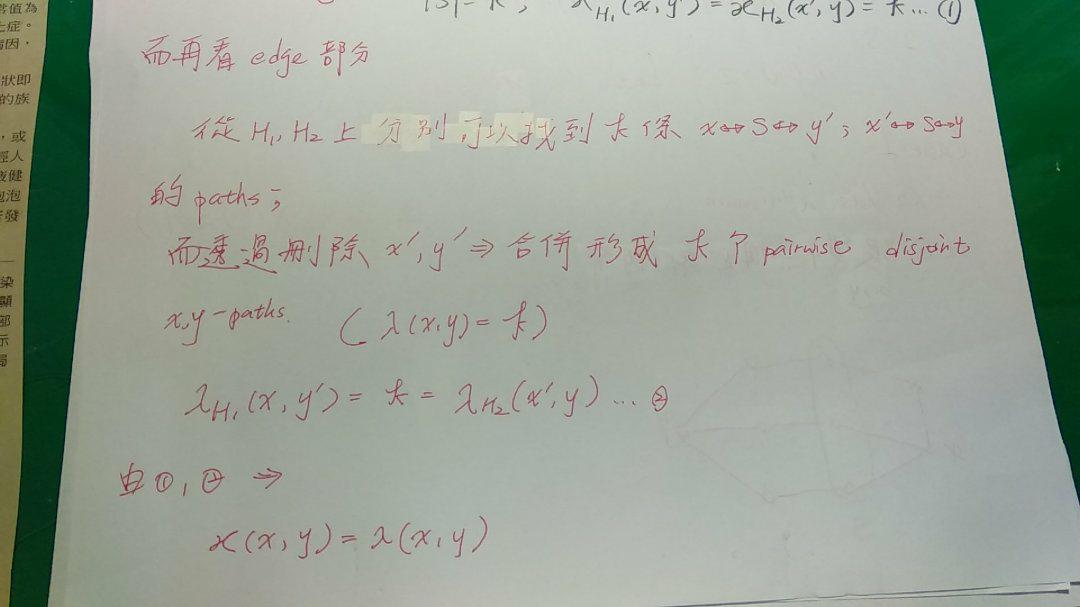
結合 Case 1-1 以及 Case 1-2,可以知道在 Case 1 假設情況下, ϰ(x,y) = λ(x,y);接下來準備進入另一個狀況討論:
Case 2 + Case 2-1
當 x,y-cut: S 集合為 x,y 的鄰居時的情況:
Case 2-1: 情況為 "當 N(x), N(y) 之間還有存在其他 vertices 時"
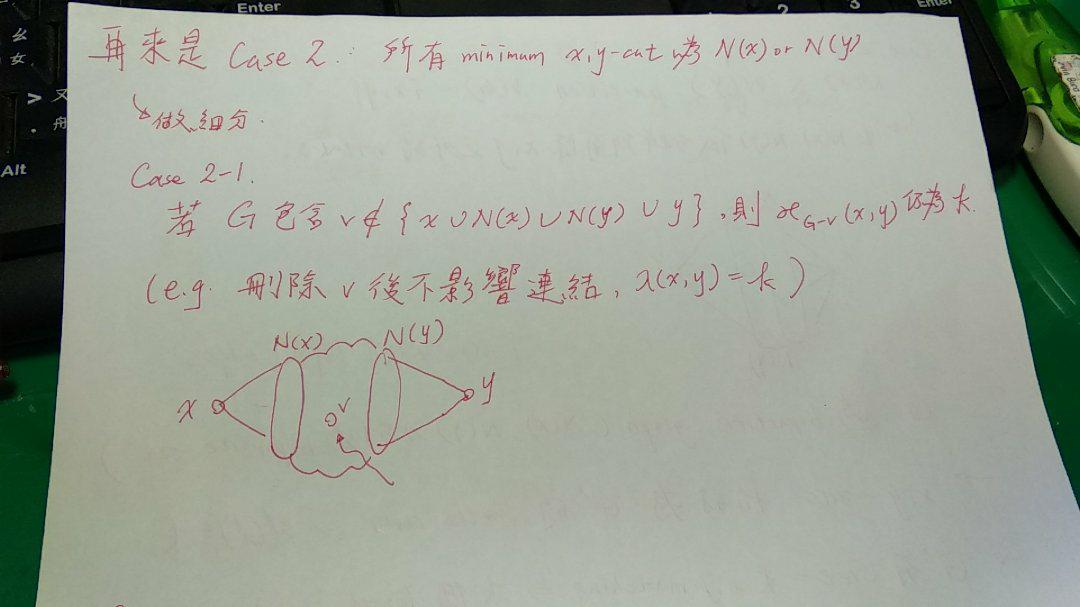
Case 2-2
Case 2-2: 情況為 "當 N(x), N(y) 之中,有部份 overlap 情況發生時"
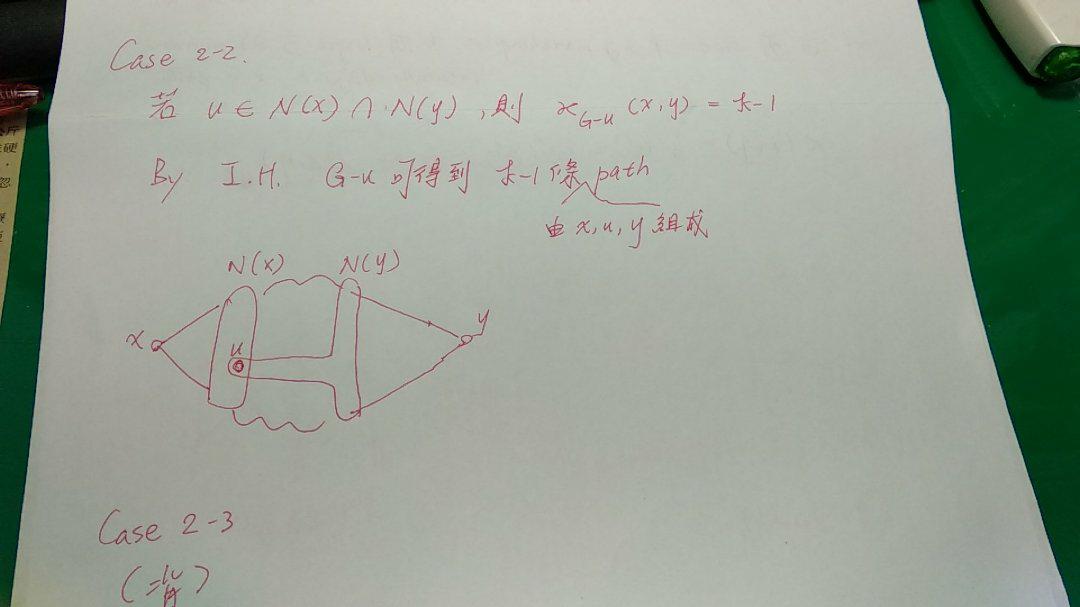
Case 2-3
Case 2-3: 情況為 "當 N(x), N(y) 互為 bipartite 之中的 partite set 時"
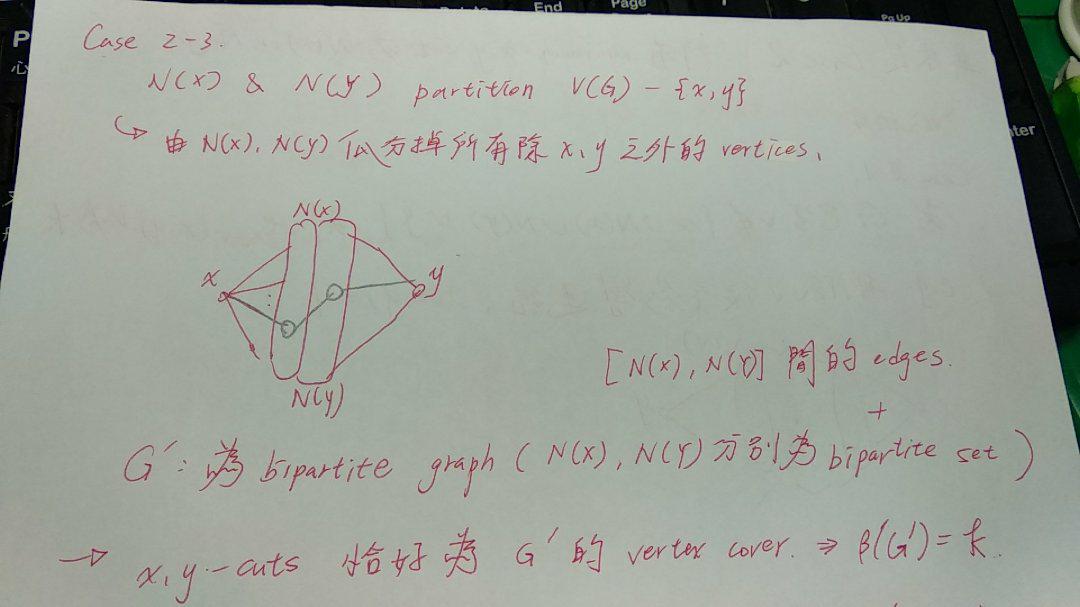
Summary
Case 2 則同樣透過這三種情況來說明 "ϰ(x,y) = λ(x,y)"
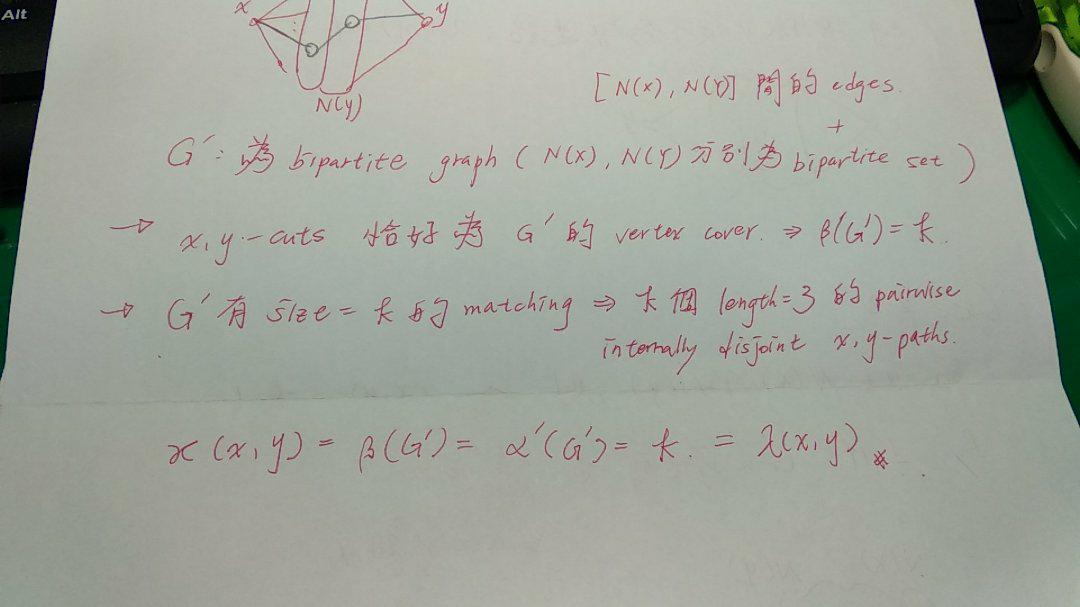
Theorem
計算 connectivity 以及 edge-connectivity ,以及 disjoint x,y-paths、 edge-disjoint x,y-paths 這兩對配對間大小
其中 λ(x,y) 為表示從 x 到 y 之間 pairwise 的 internally disjoint x,y-path 的數量 ( λ'(x,y) 則為 edge-disjoint x,y-paths set )
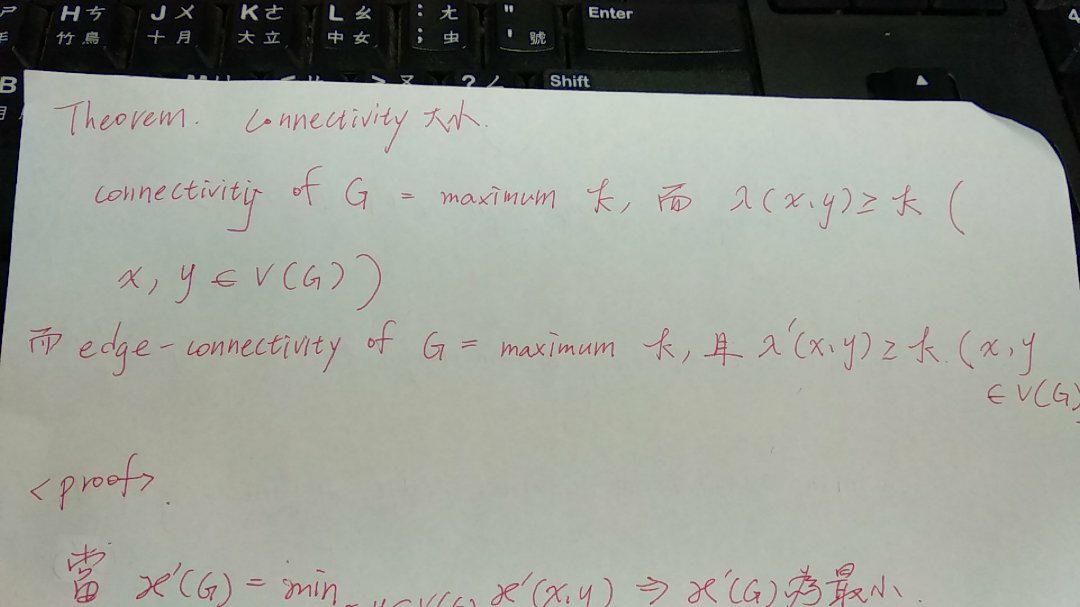
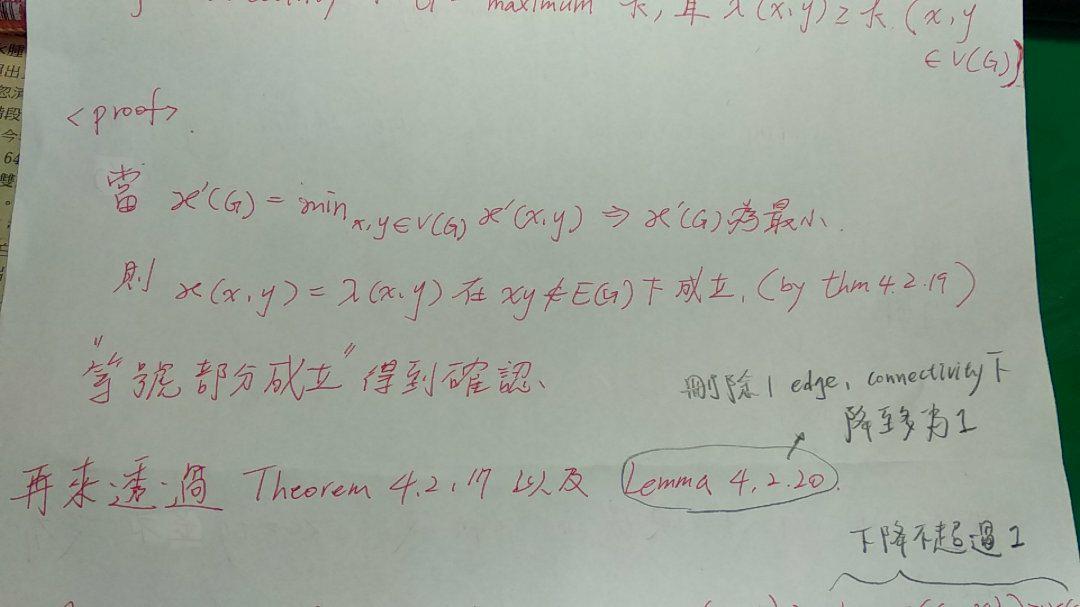
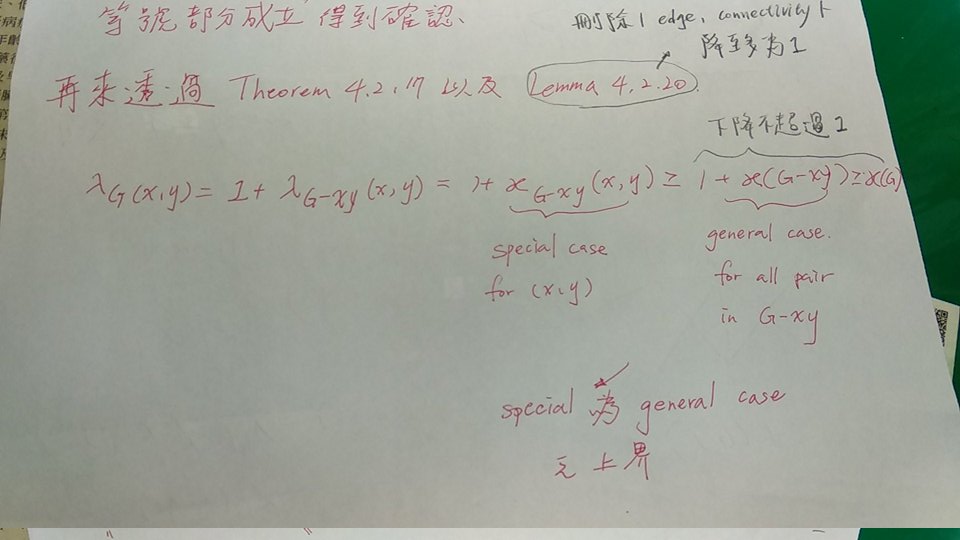
這邊主要講述跟 ear 相關的幾個定理說明,包括 ear/closed-ear、strong orientation
Theorem - ear
當一個 graph G 是為 2-connected 時,表示 G 有一個 ear decomposition; 並且每個 cycle 於 2-connected 的 graph 中皆為某個 ear decomposition 的 initial cycle
- Proof:
- 先從
Sufficiency 證明起 (若 G 有 ear decomposition,則 graph 為 2-connected)
- 假設現在 graph G 為 2-connected, 則 G 滿足條件:能夠再加入任何一個 ear 後保持 2-connected 的狀態 ->
- 設現有的 graph G 狀態為 2-connected (i.e. 擁有 ear decomposition)
- 則此時從上面找到兩點: u,v ,並且構成一個新的 ear : P (uv 間做
subdivision 的動作後,使得符合 ear 的定義:"所有內部存在的 vertices ,其 degree 皆為 2" 的條件)
- subdivision 會保持 2-connected!
- G + uv 仍為 2-connected(於此適用於繼續以相同方式加入 ear! graph G 仍會保持 2-connected)
- 再來是
Necessity 的部份 (若 G 有 2-connected,則表示 G 有 ear decomposition)
- 假設目前存在一個 graph G,其為 2-connected; 且存在一個 Cycle
C 於 G 當中
- 則此時從這個 cycle C 作為 ear decomposition 的 initial cycle 開始,逐一加入 ear 進去;做一個 iterative 的動作;
- iterative 動作:
- 挑選非目前 ear decomposition 的兩個 vertices(
u,v),再從 ear decomposition 上挑選兩個 vertices(x,y)
- 使這 4點 構成一個 cycle,這麼一來就形成新的 ear decomposition 了!
- 停止條件為,當目前的 ear decomposition 等於當初的 graph G 時,就停止
- 所以當 iterative process 結束時,便可得到一個擁有 2-connected 性質的 ear decomposition - G
Theorem - closed-ear
當一個 graph G 是為 2-edge-connected 時,表示 G 有一個 closed-ear decomposition; 並且每個 cycle 於 2-edge-connected 的 graph 中皆為某個 decomposition 的 initial cycle
(跟上面的定理類似,只是從原本針對 vertex 的 2-connected 換成 2-edge-connected)
Theorem - strong orientation
當 graph G 存在強方向性(該 graph 中所有的 undirected edge 全部替換成 directed 時稱之),則表示 G 為 2-edge-connected!
- Proof
Necessity:
- 當 graph G 存在 strong orientation 時,表示 G 不可能為 disconnected、並且不存在
cut-edge!
( strongly orientation 的性質其中就有 bridgeless,所以不會存在兩個 component 之間只有單向的 directed edge 存在的情形 )
Sufficiency:
- 當 graph G 有
2-edge-connected 性質存在時,則其有一個 closed-ear-decomposition =>
- 跟前面 ear 的定理證明類似,從 initial cycle 出發,把 initial cycle 上所有的 edge 做 orient,形成必要條件: strongly orientation
- 接著再一一加入
新的 ear(跟前面的加入方式相同),並把這些新 ear 上面 edges 做 orient
- 藉此可以得證!
Lemma 4.2.22
主要證實性質: graph 在扣除一條 edge 後,最多減少 1 個 connectivity !
=> ϰ(G - xy) <= ϰ(G),透過指出兩種情況: ϰ(G - xy) = ϰ(G) 以及 ϰ(G - xy) = ϰ(G) - 1 來做說明
